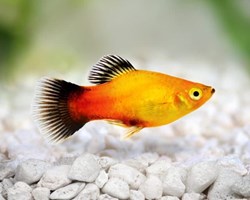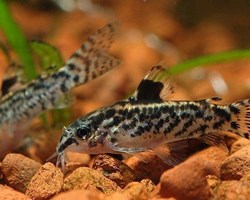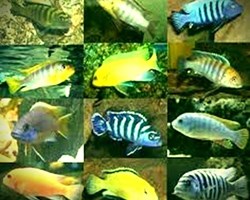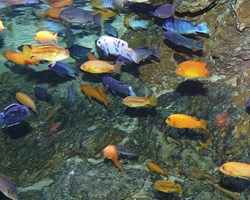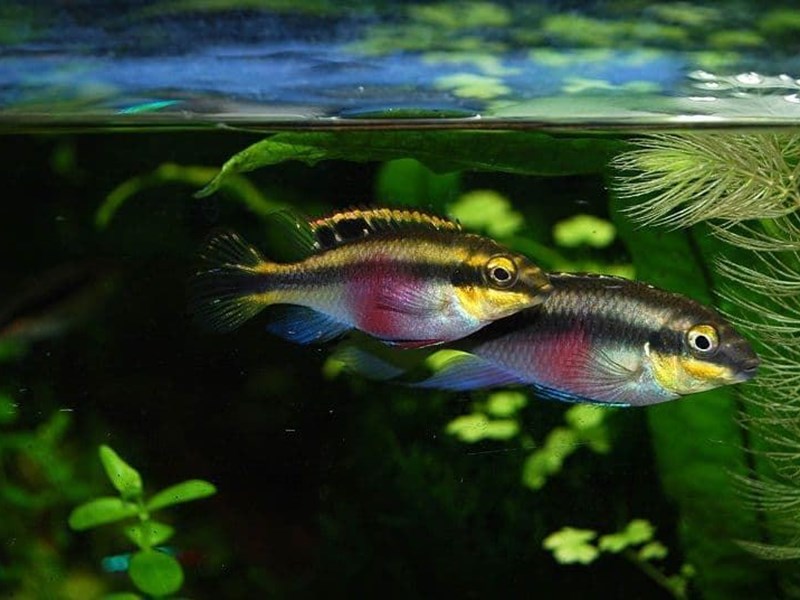
DESCRIPTION:
Scientific name: Pelvicachromis Pulcher.
Common Name: Kribensis, Purple Cichlid.
Aquarium size: 50 to 100 liters.
Temperament: Calm.
Temperature: Between 24º and 28ºC.
pH: Between 6 and 7.5.
Diet: Omnivores.
Length: 6 cm to 10 cm.
Also known as purple cichlid, it is one of the most attractively colored aquarium cichlids.
Its type of school is based on pairs, it has a life expectancy of 4 to 5 years.
The preferred aquarium zone is the lower or middle zone.
According to its taxonomy, it belongs to the Actinopterygii Class, Perciformes Order, Cichlidae (Cichlids) family and the Pelvicachromis genus.
The Kribensis fish has an elongated, semi-cylindrical and slightly compressed body, with flattened sides.
It has a variable coloration and its upper fins are usually brown with some blue or purple areas and its lower fins are bluish-white.
The male can reach up to 10 cm in length, while the females are usually smaller, reaching up to 6 or 7 cm in length.
Sexual dimorphism: Both male and female have a characteristic red spot on their belly, which is more pronounced in females.
The females are more colorful than the males, despite being smaller.
Females have a dark spot on the dorsal fin, while males have one to five spots with a yellowish edge and longer dorsal and anal fins.
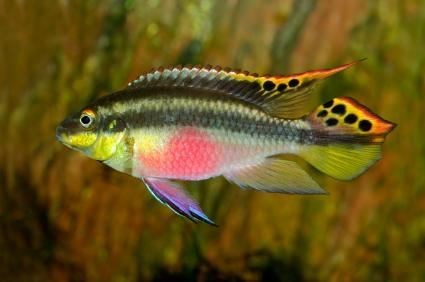
FOR YOUR BETTER CARE, IT IS NECESSARY TO KNOW ITS DISTRIBUTION AND HABITAT:
The Pelvicachromis Pulcher is a fish found in the fluvial region of Africa.
They inhabit the lower courses of rivers in the western area of southern Nigeria and Cameroon, areas where vegetation abounds.
They have been artificially introduced in some areas, such as Hawaii.
It can develop both in calm waters and in current areas, but always conditioned to the existence of dense vegetation.
It is usually found both at the mouths of rivers in the sea where the water is slightly brackish, as well as in soft water rivers.
THE BEST CONDITIONS OF THE AQUARIUM:
At Glu Glu Pet we recommend an aquarium that is at least 60 cm long, and has a capacity of at least 60 liters of water.
If you want to have a couple of these fish, it would be ideal to have at least 80 liters of water.
In the case of having two pairs of this species, it is recommended that the aquarium has a measure of more than 1 meter in length and at least 100 liters of water, to avoid or reduce attacks during the breeding season.
Place decorative material such as vegetation, roots, logs, clay pots, and small stones in the aquarium.
These materials will serve as hiding places and places to spawn their eggs.
This fish is very adaptable and the most suitable conditions for aquarium water are:
- Water pH: a range of 6.5 -7.5 is recommended.
- A really important aspect is that this range remains stable.
- The temperature that the aquarium water should present must correspond to a tropical habitat, that is, as far as possible, between 24 and 28ºC; always trying to keep as few temperature variations as possible, maximum 1ºC per day.
- The hardness of the water must be maintained between 5º and 20º dGH.
Frequent water changes are necessary, in addition to periodic cleaning of the bottom and walls of the aquarium, due to the large amount of waste and feces that these fish generate when they feed.
It is necessary that the aquarium has a biological filtration system that helps keep the aquarium clean.
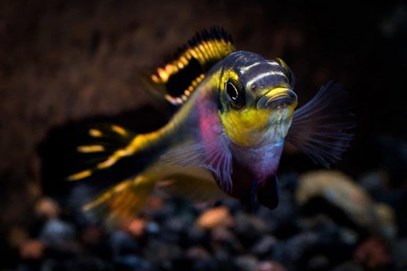
THE BEST NUTRITION FOR THE PURPLE CICHLID:
The Kribensis are omnivores, they can be fed with frozen or live food.
A varied diet is recommended for them, as far as possible with little or no processed food, whether frozen, freeze-dried, porridge or live prey. They will gladly accept good quality dry food flakes or pellets.
TO TAKE CARE OF IT, YOU MUST KNOW ITS BEHAVIOR AND COMPATIBILITY:
As long as it is not its breeding season, it can be an extremely passive and to a certain extent shy fish, ideal for shared aquariums, called community ones.
It is not territorial, it will then explore the entire bottom of the aquarium and the middle part calmly and calmly, being able to be really fast and agile if it were to need it at any time.
Glu Glu Pet also recommends that you have calm fish in the aquarium that are not very skittish, such as some kind of school of corydoras, so that they provide a sense of "no danger" to the kribensi and encourage it to walk around the aquarium.
In the reproductive or breeding phase, their behavior changes radically.
When living as a couple, it aggressively defends its territory as a father-mother pair, which can reach up to 1m2.
It is dedicated to actively guarding its nest from other fish and from any inhabitant of the aquarium. It is also responsible for scaring away the rest of the fish, while it goes out with its young to look for food.
It is usually more aggressive with fish of its own species, and to a much lesser degree with different species.
On certain occasions they can mercilessly attack Escalars and also harass Corydoras.
To keep a better control of the situation, as far as possible the Kribensis tankmates are inhabitants of the middle and upper zones of the aquarium.
Compatible fish without restrictions:
- Molly fish.
- Pearl Gourami.
- Zebra fish.
- Nun fish.
- Platy.
- Rasbora Galaxy.
- Guppies.
- Guppy Endler.
- Climb.
- Chinese neon.
- Tiger Barb.
- Ramirezi.
- Drunken Fish.
- Silver Dollar.
- Ax Fish.
- Tetra Neon.
- Tetra Cardinal.
Fish compatible with restrictions:
- betta.
- Goldfish.
- Telescope.
- Discus fish.
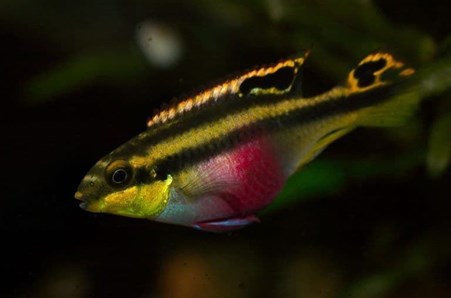
THE REPRODUCTION: OF THE PURPLE CICHLID:
If captive breeding is desired, keep the pH of the aquarium water very close to neutral if a sex ratio of approximately 50:50 is to be preserved.
If the pH is more acidic and the water softer, then a greater proportion of males will be obtained, on the contrary, with alkaline pH conditions and harder water, a greater proportion of females will be obtained.
The act of mating is usually very interesting.
In this ritual, the female intensifies her colors and bends into a "U" shape.
72 hours after the eggs have been spawned, they hatch.
After five days, the fry can go out to find food accompanied by their parents.

